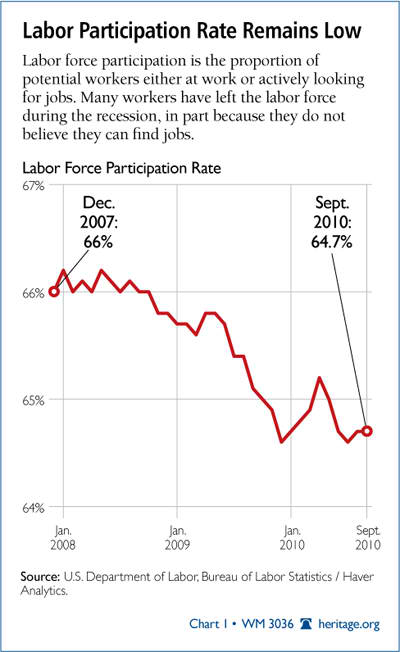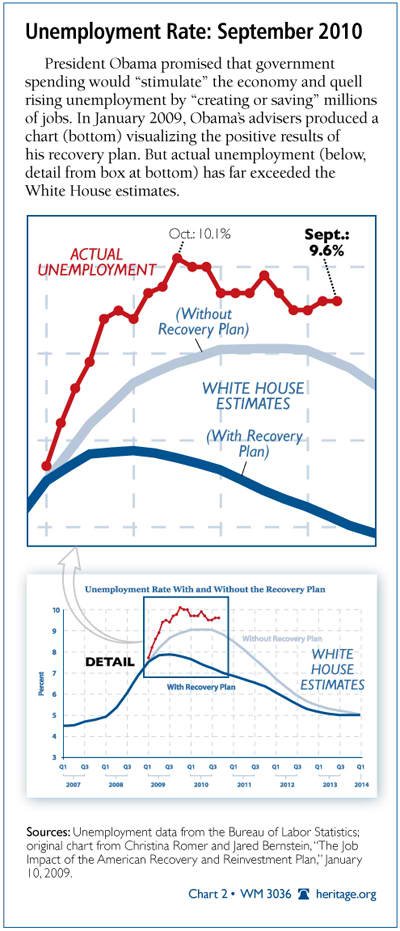Earlier this year some economists and politicians predicted a “recovery summer” during which private sector job creation would finally pick up. This did not happen—employers created few jobs and unemployment remained high. This stagnation continued in September as unemployment remained unchanged at 9.6 percent and private-sector employers added a net of just 64,000 jobs. Worse, revised data show that the economy lost 366,000 more jobs than initially estimated between March 2009 and March 2010.
Given these numbers, now is the wrong time for Congress to raise taxes. Congress should maintain current tax rates at least until unemployment returns to normal levels.
September Employment Report
The Bureau of Labor Statistics (BLS) monthly employment report shows that the economy remained stagnate in September, losing a net of 95,000 jobs. The government accounted for these net job losses with temporary Census employment (-77,000) and state and local government employment (-83,000) both falling. Private-sector employers modestly expanded their payrolls (+64,000). However these new private-sectors jobs are not enough to make a meaningful dent in the unemployment rate, which remained unchanged at 9.6 percent.
Weak job gains occurred throughout the private sector. Both the construction (-21,000) and manufacturing (-6,000) sectors continued to lose jobs. The largest job gains came in the leisure and hospitality (+38,000) and healthcare and social assistance (+32,000) fields. The growth in temporary help services employment (+16,900) provided one encouraging sign, as employers often hire temporary workers before committing to full-time employees.

Average weekly work hours (34.2) and the labor force participation rate (64.7 percent) also remained flat in September. The labor force participation rate measures the portion of the population that is either at work or looking for work. The fact that it has fallen by 1.3 percentage points since the recession began indicates that many workers do not believe they can find work. Increased labor force participation in the spring had led economists to believe that a recovery might be imminent. Yet, over the summer, labor force participation fell again, and has not recovered.
Revisions Show More Job Losses
Every year the BLS revises its employment figures to include data from unemployment insurance records. The BLS releases preliminary figures in September and their final estimates the following February. The preliminary estimates show that the economy lost 366,000 more jobs between March 2009 and March 2010 than previously estimated. The current official figures show that private-sector employment has fallen by 7.6 million jobs since the recession began. Accounting for these revisions, however, shows that private-sector employment has actually fallen by 7.97 million jobs. A great deal of progress must be made before the labor market can be considered to be in recovery.
No Time to Raise Taxes
With the economy this weak, Congress should not even consider raising taxes. Every major school of economic thought—from neo-classical to neo-Keynesian—agrees that governments should not raise taxes during a recession. Unfortunately, the Obama Administration and congressional Democrats plan to raise the top two income tax brackets as well as raising taxes on capital.
The Heritage Foundation Center for Data Analysis estimated the likely economic and fiscal effects of the Obama tax plan by introducing it into a model of the U.S. economy, the same model that leading government agencies and Fortune 500 companies use to make economic forecasts.[1] According to this model, these tax increases would significantly damage the U.S. economy, harming the poor, the middle class, and the rich alike. Specifically, the Obama tax-increase plan would result in:[2]
• Slower economic growth: Inflation-adjusted gross domestic product (GDP) would fall by a total of $1.1 trillion between FY 2011 and FY 2020. GDP in 2018 would fall by $145 billion alone. The growth rate of the economy would be slower for the entire 10-year period;
• Fewer jobs: Slower economic growth would result in less job creation. Employment would fall by an average of 693,000 jobs per year over this period;
- 238,000 fewer jobs in the critical economic recovery year of 2011; and
- In one year alone, 2016, job losses top 876,000.
• More unemployed Americans: Slower growth in employment translates to a higher unemployment rate, which would rise more each year during the 10-year period than it would without the Obama tax hikes. In other words, for Americans who are unemployed now, their prospects of employment would worsen under the Obama tax plan.
These negative economic impacts will be mirrored by several other key economic indicators:
- Business investment would fall every year of the 10-year period by an average of $33 billion below the non-tax-hike level;
- Investment in residences would fall by an average of $13 billion each year;
- Personal savings would decrease by $38 billion in 2011 alone, and savings by Americans would continue below baseline for each of the following four years;
- Total disposable lost income after subtracting inflation would equal $726 billion for the 10-year period; and
- Lost consumer spending after inflation would equal $706 billion over this time period.
In short, the economic harm is significant and widespread. Individuals and households across the income spectrum will bear the brunt of the economic slowdown, resulting in fewer employment opportunities, lower wages, lost consumption, and lower savings. Congress needs to understand that it will be raising additional revenues on the backs of those citizens it tries to help through income-redistribution programs.

Government spending has failed to lift the economy out of the recession. Unemployment has risen above what the President’s advisors predicted would happen if Congress did not pass the stimulus. The federal government cannot plan a recovery from Washington. Instead, Congress should keep taxes from rising, which will in turn encourage businesses and entrepreneurs to expand and invest.
New Fiscal Balancing Point Needed
The labor market continued to stagnate in September. Private-sector employers added only 64,000 jobs—not enough to make a meaningful dent in the unemployment rate which remained unchanged at 9.6 percent. Revisions to earlier figures show that the economy lost 366,000 more jobs than previously estimated. Visions of a “recovery summer” have proven to be a mirage. If this news was not dire enough, now Congress and the Obama Administration plan to raise taxes.
Every major economic school of thought advises against raising taxes in a recession. Macroeconomic modeling shows that these planned tax increases would cost jobs, reduce new investment, and reduce economic growth. The economic effects would hurt Americans up and down the income distribution bracket. Congress should not allow these tax increases to take effect. Congress should instead come to terms with the need to find a new fiscal balancing point through lower spending and fundamental entitlement reform that also supports strong economic growth.
James Sherk is Senior Policy Analyst in Labor Economics, and Karen A. Campbell, Ph.D., is Policy Analyst in Macroeconomics, in the Center for Data Analysis at The Heritage Foundation.



